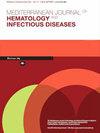THALIDOMIDE AMELIORATES ERYTHROPOIESIS AND IRON HOMEOSTASIS IN TRANSFUSION-DEPENDENT β-THALASSEMIA
IF 2
4区 医学
Q3 HEMATOLOGY
Mediterranean Journal of Hematology and Infectious Diseases
Pub Date : 2024-01-01
DOI:10.4084/mjhid.2024.001
引用次数: 0
Abstract
Thalidomide is a therapeutic option for patients with β-thalassemia by increasing fetal hemoglobin and thereby reducing the requirement for blood transfusions. However, information on changes in erythropoiesis and iron homeostasis during thalidomide treatment is lacking. This study investigated the effects of thalidomide treatment on hematologic, erythropoietic, and iron-status parameters in 22 patients with transfusion-dependent β-thalassemia (TDT). Thalidomide significantly improved anemia endpoints, including increases in hemoglobin (p<0.001), red blood cells (p<0.001), and hematocrit (p<0.001), as well as reducing erythropoietin levels (p=0.033) and ameliorating erythropoiesis. Thalidomide treatment significantly reduced serum iron levels (p=0.018) and transferrin saturation (p=0.039) and increased serum transferrin levels (p=0.030). Thalidomide had no observed effect on serum ferritin or hepcidin, but changes in hepcidin(r=0.439, p=0.041) and serum iron (r=−0.536, p=0.010) were significantly correlated with hemoglobin increment. This comprehensive study indicates that thalidomide treatment can ameliorate erythropoiesis and iron homeostasis in patients with TDT, thus supporting the effectiveness of this drug.他利多美能改善转移依赖性 β-高血脂症的血红蛋白增多症和铁同形反应
沙利度胺可增加胎儿血红蛋白,从而减少输血需求,是β地中海贫血患者的一种治疗选择。然而,有关沙利度胺治疗期间红细胞生成和铁稳态变化的信息尚缺。本研究调查了沙利度胺治疗对22名输血依赖型β地中海贫血(TDT)患者血液学、红细胞生成和铁稳态参数的影响。沙利度胺能明显改善贫血终点,包括血红蛋白(p<0.001)、红细胞(p<0.001)和血细胞比容(p<0.001)的增加,以及红细胞生成素水平的降低(p=0.033)和红细胞生成的改善。沙利度胺治疗可明显降低血清铁水平(p=0.018)和转铁蛋白饱和度(p=0.039),提高血清转铁蛋白水平(p=0.030)。沙利度胺对血清铁蛋白和血红素没有观察到影响,但血红素(r=0.439,p=0.041)和血清铁(r=-0.536,p=0.010)的变化与血红蛋白增量显著相关。这项综合研究表明,沙利度胺治疗可改善TDT患者的红细胞生成和铁平衡,从而支持了该药物的有效性。
本文章由计算机程序翻译,如有差异,请以英文原文为准。
求助全文
约1分钟内获得全文
求助全文
来源期刊

Mediterranean Journal of Hematology and Infectious Diseases
Medicine-Hematology
CiteScore
4.20
自引率
6.20%
发文量
113
审稿时长
12 weeks
期刊介绍:
Reciprocal interdependence between infectious and hematologic diseases (malignant and non-malignant) is well known. This relationship is particularly evident in Mediterranean countries. Parasitosis as Malaria, Leishmaniosis, B Hookworms, Teniasis, very common in the southeast Mediterranean area, infect about a billion people and manifest prevalently with anemia so that they are usually diagnosed mostly by experienced hematologist on blood or bone marrow smear. On the other hand, infections are also a significant problem in patients affected by hematological malignancies. The blood is the primary vector of HIV infection, which otherwise manifest with symptoms related to a reduction in T lymphocytes. In turn, infections can favor the insurgency of hematological malignancies. The causative relationship between Epstein-Barr virus infection, Helicobacter pylori, hepatitis C virus, HIV and lymphoproliferative diseases is well known.
 求助内容:
求助内容: 应助结果提醒方式:
应助结果提醒方式:


